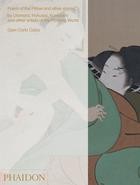Shunga, such as the famous Japanese erotic pillow books, also known
euphemistically as ‘spring images’, were vibrant, curious and explicit
documents of sexual life, designed to inform, thrill and entertain. This
book presents a comprehensive modern study on Japanese erotic art,
illustrating a large selection of the best works from public as well as
private collections from around the world.
Far from being a separate genre, Shunga constitutes at least half of the
output of all ukiyo-e art, and often the largest part of any given
artist’s production. This continuity, once surprising, is now only
recently beginning to be taken for granted, between the greatest
masterpieces of ukiyo-e art, often acclaimed for their subtlety,
elegance, refinement and novel composition, and the blatantly
pornographic images produced by the same artists.
The social and religious attitudes of pre-modern Europe both prevented
the appreciation of Shunga prints. The cultural context of pre-modern
Japan was markedly different to that of Europe, and allowed a vibrant,
uninhibited and widely circulated genre of erotic imagery to develop.
Edmond de Goncourt first started to collect Japanese art works including
Shunga prints, and published the first monograph on a Japanese artist
in 1891. De Goncourt’s interest in Utamaro gave sexualised prints
particular importance, making them integral to the history of Japanese
art and its reception in the Western world. Artists such as Edgar Degas,
Vincent Van Gogh, Francis Bacon and Gauguin among many others were
known for their love of Shunga prints and were influenced by the unusual
framing and arbitrary colours of Japanese printing methods. Shunga
notably came to the West during the Art Nouveau period when collecting
Japanese prints became popular, and traces of Shunga styles and elements
have visibly influenced this artistic period. The most famous and
recognizable shunga work is Hokusai’s depiction of a young woman being
ravished by an octopus in his album Pining for Love.
Compared to Western perceptions of the nude and its associations with
sex and the Christian concept of original sin, mere nakedness held
little erotic interest to the Japanese viewer. This explains why
Japanese erotica is so extreme in its sexual depictions and why many of
the prints, paintings and scrolls illustrated in this book depict
clothed or half clothed figures. Some Shunga illustrated famous tales,
such as the Tale of Genji, an eleventh century novel which concentrated
on the romantic life of the son (Genji) of a Japanese emperor. This is
the case of many works by important ukiyo-e artists, included in this
publication, such as Moronobu, Kunisada, Harunobu and Eizan among
others.
Much if not most Shunga was published in book form, as opposed to the
single sheets that dominate the ‘normal’ ukiyo-e market, which allowed
pictures to be easily carried about and, importantly, stored
unobtrusively. This is the case of Utamaro’s famous album, Poem of the Pillow,
which is reproduced in this publication in its entirety, as are many
albums notably by Hokusai, Harunobu, Kuniyoshi and many others.
The book also illustrates some of the rarer Shunga works such as the
beautiful handscrolls made by such artists as Kyonobu, Sukenobu and
Shuncho. These demonstrate particularly the expressive vibrancy of
colour and interest in surface pattern that are aesthetically important
in the Japanese print.
Gian Carlo Calza’s insightful text is accompanied by 350 colour images,
offering a great variety of examples from traditional Japanese erotica.
The book comprises of a general introduction which sets the artists and
their work in their social, historical and artistic context. The book is
then organised by artist with a short text on each artist, introducing
the illustrated works. The author references the latest in art
historical scholarship, but this book is also aimed at readers who may
not have specialist knowledge or extensive familiarity with Japanese
culture.
EAN: 9780714849966
Vydavateľstvo: Phaidon
Autori: Gian Carlo Calza
Rok vydania: 2010
Jazyk: Anglický



